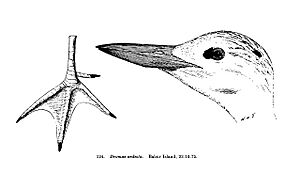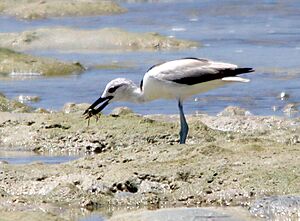Crab-plover facts for kids
Quick facts for kids Crab-plover |
|
|---|---|
 |
|
| Conservation status | |
| Scientific classification | |
| Genus: |
Dromas
|
| Species: |
ardeola
|
 |
|
The crab-plover (Dromas ardeola) is a unique bird that lives near water. It's related to waders, which are birds that often walk in shallow water. However, the crab-plover is so special that it has its very own family, called Dromadidae. It's the only bird in its group, the genus Dromas.
One super cool thing about the crab-plover is how it keeps its eggs warm. Unlike most waders, it uses the natural heat from the ground to help its eggs hatch!
What Does a Crab-Plover Look Like?
This bird looks a bit like a plover, but it has some very distinct features. It has long, grey legs and a strong, thick black beak that looks a bit like a tern's. Its feathers are black and white, and it stands tall with a long neck. These features make it easy to spot!
The crab-plover's beak is truly special among waders. It's perfectly designed for eating crabs, which are its favorite food. Its toes are also partly webbed, which helps it move around in sandy or muddy areas.
Most of its body is white, but its back and the main feathers on its wings are black. These birds can be quite noisy! They often call out, especially when they are nesting or in their winter homes. Their usual call sounds like a quick, repeated "ka." When many of them are together, they can make a whinnying sound. During breeding season, they might even make whistling "kew-ki-ki" notes.
It's hard to tell male and female crab-plovers apart, but males usually have a slightly bigger and heavier beak. Young crab-plovers have greyish-black feathers on their back and keep this look for about a year. When they fly, they often form lines or "V" shapes in the sky.
Where Do Crab-Plovers Live?
Crab-plovers live along the coasts and islands of the Indian Ocean. They are often found in places like the Arabian Sea, Gulf of Oman, Persian Gulf, Red Sea, and Somalia.
These birds are very social and like to feed in big groups. They don't just eat during the day; they also hunt for food at night, and during dawn and dusk. This is especially common when they are raising their young.
They breed from April to July in the areas around the Arabian Sea. After breeding, they spread out across the Indian Ocean. You can find them as far east as the Andaman Islands and Sri Lanka, and as far south as Tanzania and Madagascar.
How Do Crab-Plovers Raise Their Young?
Crab-plovers are quite unusual for waders because they build their nests in burrows. They dig these burrows into sandy banks. In places like the Red Sea, they start nesting around mid-May.
They are also colonial birds, meaning they nest in large groups. Some colonies can have as many as 1,500 pairs of birds! Each pair usually lays one large white egg, though sometimes they lay two.
The temperature inside their nest burrows is just right because of the sun's heat. This means the parent birds can leave the nest for a long time, sometimes up to 58 hours, and the eggs will still stay warm.
When the chicks hatch, they are very helpless. Most wader chicks can walk soon after hatching, but crab-plover chicks cannot. They stay in the nest for several days, and their parents bring them food. Even after they learn to fly, they still need their parents to care for them for a long time. Both the male and female crab-plovers help look after the young.




